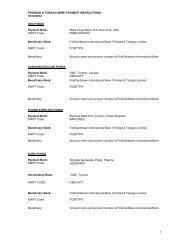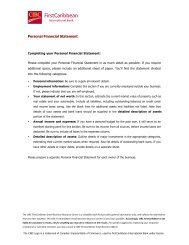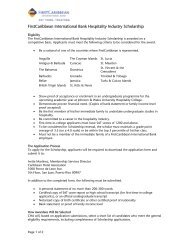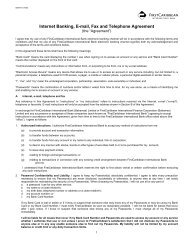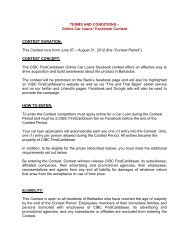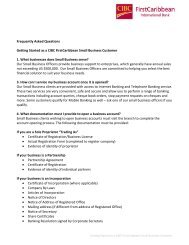FirstCaribbean International Bank (Bahamas) Limited
FirstCaribbean International Bank (Bahamas) Limited
FirstCaribbean International Bank (Bahamas) Limited
- No tags were found...
Create successful ePaper yourself
Turn your PDF publications into a flip-book with our unique Google optimized e-Paper software.
Notes to Consolidated Financial StatementsFor the year ended October 31, 2009(Expressed in thousands of Bahamian dollars)26. Financial Risk Management (Continued)B. Credit risk (continued)Impaired financial assets and provision for credit lossesThe <strong>Bank</strong> takes on exposure to credit risk, which is the risk that a counter party will be unable to pay amounts in fullwhen due. The <strong>Bank</strong> structures the levels of credit risk it undertakes by placing limits on the amount of risk acceptedin relation to one counter party, borrower, or groups of borrowers, and to geographical and industry segments. Suchrisks are monitored on a revolving basis and subject to an annual or more frequent review.The exposure to any single counterparty, including banks and brokers, is further restricted by sub-limits coveringon and off-balance sheet exposures and daily delivery risk limits in relation to trading items such as forward foreignexchange contracts. Actual exposures against limits are monitored daily.Exposure to credit risk is managed through regular analysis of the ability of borrowers and potential borrowers to meetinterest and capital repayment obligations and by changing these lending limits where appropriate. Exposure to creditrisk is also managed in part by obtaining collateral, including corporate and personal guarantees.DerivativesThe <strong>Bank</strong> maintains strict control limits on net open derivative positions, that is, the difference between purchaseand sale contracts, by both amount and term. At any one time the amount subject to credit risk is limited to thecurrent fair value of instruments that are favourable to the <strong>Bank</strong> (i.e. assets), which in relation to derivatives is only asmall fraction of the contract or notional values used to express the volume of instruments outstanding. This creditrisk exposure is managed as part of the overall lending limits with customers, together with potential exposures frommarket movements. Collateral or other security is not usually obtained for credit risk exposures on these instruments,except where the <strong>Bank</strong> requires margin deposits from counterparties.Master netting arrangementsThe <strong>Bank</strong> further restricts its exposure to credit losses by entering into master netting arrangements with counterpartieswith which it undertakes a significant volume of transactions. Master netting arrangements do not generally result inan offset of consolidated balance sheet assets and liabilities as transactions are usually settled on a gross basis. However,the credit risk associated with favourable contracts is reduced by a master netting arrangement to the extent that if anevent of default occurs, all amounts with the counterparty are terminated and settled on a net basis. The <strong>Bank</strong>’s overallexposure to credit risk on derivative instruments subject to master netting arrangements can change substantiallywithin a short period since it is affected by each transaction subject to the arrangement.Credit related commitmentsThe primary purpose of these instruments is to ensure that funds are available to a customer as required. Guaranteesand standby letters of credit, which represent irrevocable assurances that the <strong>Bank</strong> will make payments in the eventthat a customer cannot meet its obligations to third parties, carry the same credit risk as loans. Documentary andcommercial letters of credit, which are written undertakings by the <strong>Bank</strong> on behalf of a customer authorizing a thirdparty to draw drafts on the <strong>Bank</strong> up to a stipulated amount under specific terms and conditions, are collateralized bythe underlying shipments of goods to which they relate and therefore carry less risk than a direct borrowing.Commitments to extend credit represent unused portions of authorizations to extend credit in the form of loans,guarantees or letters of credit. With respect to credit risk on commitments to extend credit, the <strong>Bank</strong> is potentiallyexposed to loss in an amount equal to the total unused commitments. However, the likely amount of loss is less thanthe total unused commitments since most commitments to extend credit are contingent upon customers maintainingspecific credit standards. The <strong>Bank</strong> monitors the term of maturity of credit commitments because longer-termcommitments generally have a greater degree of credit risk than shorter-term commitments.Maximum exposure to credit riskThe maximum exposure to credit risk would be all consolidated balance sheet carrying values of all financial assetsplus the off-balance sheet contingent liabilities and commitments (Note 23). The gross maximum exposure wouldbe before allowance for credit losses and the effect of mitigation through the use of master netting and collateralarrangements.56The maximum exposure to credit risk within the customer loan portfolio would be all the consolidated balance sheetcarrying values plus the off-balance sheet loan commitment amounts (Note 23). The gross maximum exposure withinthe customer loan portfolio would be before allowance for credit losses and the effect of mitigation through the use ofmaster netting and collateral arrangements, plus the off-balance sheet loan commitments amount.



